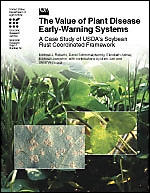The Value of Plant Disease Early-Warning Systems: A Case Study of USDA's Soybean Rust Coordinated Framework
- by Michael Robbins, David Schimmelpfennig, Elizabeth Ashley, Michael Livingston, Mark Ash and Utpal Vasavada
- 4/3/2006
Overview
Early-warning systems for plant diseases are valuable when the systems provide timely forecasts that farmers can use to inform their pest management decisions. To evaluate the value of the systems, this study examines, as a case study, USDA's coordinated framework for soybean rust surveillance, reporting, prediction, and management, which was developed before the 2005 growing season. The framework's linchpin is a website that provides real-time, county-level information on the spread of the disease. The study assesses the value of the information tool to farmers and factors that influence that value. The information's value depends most heavily on farmers' perceptions of the forecast's accuracy. The study finds that the framework's information is valuable to farmers even in a year with a low rust infection like that of 2005. We estimate that the information provided by the framework increased U.S. soybean producers' profits by a total of $11-$299 million in 2005, or between 16 cents and $4.12 per acre, depending on the quality of information and other factors. The reported cost of the framework was between $2.6 million and almost $5 million in 2005.
Download
-
Entire report
Download PDF -
Report summary
Download PDF -
Abstract, Acknowledgments, Contents, and Summary
Download PDF -
Introduction
Download PDF -
Valuing the Information Provided by the Coordinated Framework
Download PDF -
Results
Download PDF -
Aggregate Costs and Benefits of USDA?s Coordinated Rust Framework
Download PDF -
Conclusions and Cautions
Download PDF -
References
Download PDF -
Abbreviations
Download PDF -
Appendix: Modeling the Value of Information
Download PDF
We’d welcome your feedback!
Would you be willing to answer a few quick questions about your experience?

